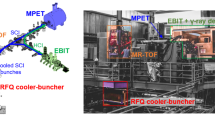Abstract
SHIPTRAP will allow direct measurement of masses of transuranium nuclides. The method of choice is a Penning trap spectrometer coupled to the SHIP (Separator for Heavy Ion Products) facility at GSI, Darmstadt. In this paper the impact of the SHIPTRAP facility, with its capability of systematic mass measurements with high precision, is explored. Rather few masses of nuclides above uranium are presently known experimentally. In the region of nuclides above Z = 100 no ground state masses were measured directly. SHIPTRAP will play an important role in systematically map** out this area. Possible candidates for direct mass measurements, even with small or very small production cross sections, are presented.
Access this chapter
Tax calculation will be finalised at checkout
Purchases are for personal use only
Preview
Unable to display preview. Download preview PDF.
Similar content being viewed by others
References
Bollen, G. et al., Nucí Instrum. Methods A 368 (1996), 675.
Münzenberg, G. et al., Nucl Instrum. Methods 161 (1979), 65.
Dilling, J. et al., Hyp. Interact. 127 (1999), 491.
Marx, G. et al., this issue, p. 463.
Audi, G. and Wapstra, A. H., Nuclear Phys. A 595 (1995), 409.
Dilling, J., PhD Thesis, University of Heidelberg, in preparation.
Bradley, M. P. et al., Phys. Rev. Lett. 83 (1999), 4510.
Hofmann, S. et al., Z. Phys. A 350 (1995), 281.
Hofmann, S. et al., Z. Phys. A 354 (1996), 229.
Patyk, Z. and Sobiczewski, A., Nuclear Phys. A 533 (1991), 132.
Geisel, H. et al., Nuclear Phys. A, submitted.
Author information
Authors and Affiliations
Editor information
Editors and Affiliations
Rights and permissions
Copyright information
© 2001 Kluwer Academic Publishers
About this paper
Cite this paper
Dilling, J. et al. (2001). A Physics Case for SHIPTRAP: Measuring the Masses of Transuranium Elements. In: Lunney, D., Audi, G., Kluge, HJ. (eds) Atomic Physics at Accelerators: Mass Spectrometry. Springer, Dordrecht. https://doi.org/10.1007/978-94-015-1270-1_56
Download citation
DOI: https://doi.org/10.1007/978-94-015-1270-1_56
Publisher Name: Springer, Dordrecht
Print ISBN: 978-90-481-5825-6
Online ISBN: 978-94-015-1270-1
eBook Packages: Springer Book Archive




